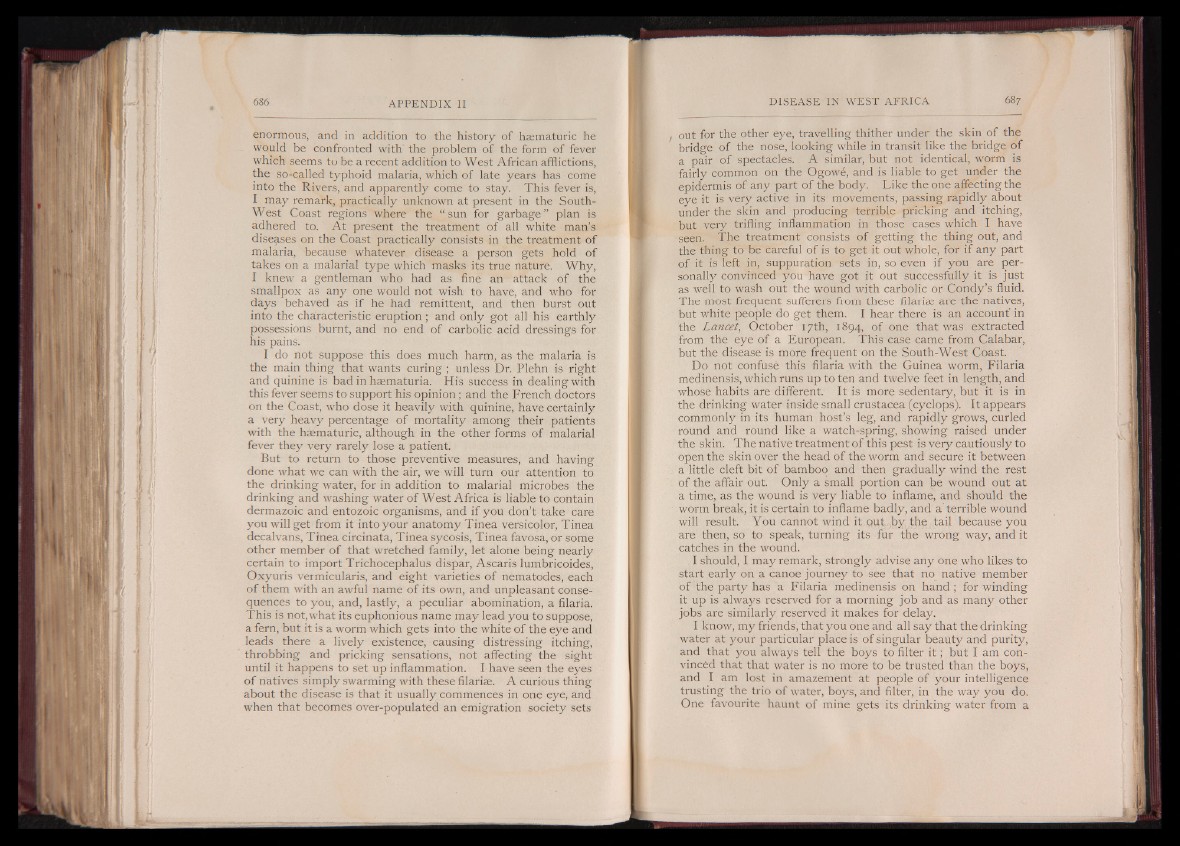
enormous, and in addition to the history of haematuric he
would be confronted with' the problem of the form of fever
which seems to be a recent addition to West African afflictions,
the so-called typhoid malaria, which of late years has come
into the Rivers, and apparently come to stay. This fever is,
I may remark, practically unknown at present in the South-
West Coast regions where the “ sun for garbage” plan is
adhered to. At present the treatment of all white man’s
diseases on the Coast practically consists in the treatment of
malaria, because whatever disease a person gets hold of
takes on a malarial type which masks its true nature. Why,
I knew a gentleman who had as fine an attack of the
smallpox as any one would not wish to have, and who for
days behaved as if he had remittent, and then burst out
into the characteristic eruption ; and only got all his earthly
possessions burnt, and no end of carbolic acid dressings for
his pains.
I do not suppose this does much harm, as the malaria is
the main thing that wants curing ; unless Dr. Plehn is right
and quinine is bad in hsematuria. His success in dealing with
this fever seems to support his opinion; and the French doctors
on the Coast, who dose it heavily with quinine, have certainly
a very heavy percentage of mortality among their patients
with the haematuric, although in the other forms of malarial
fever they very rarely lose a patient.
But to return to those preventive measures, and having
done what we can with the air, we will turn our attention to
the drinking water, for in addition to malarial microbes the
drinking and washing water of West Africa is liable to contain
dermazoic and entozoic organisms, and if you don’t take care
you will get from it into your anatomy Tinea versicolor, Tinea
decalvans, Tinea circinata, Tinea sycosis, Tinea favosa, or some
other member of that wretched family, let alone being nearly
certain to import Trichocephalus dispar, Ascaris lumbricoides,
Oxyuris vermicularis, and eight varieties of nematodes, each
of them with an awful name of its own, and unpleasant consequences
to you, and, lastly, a peculiar abomination, a filaria.
This is not, what its euphonious name may lead you to suppose,
a fern, but it is a worm which gets into the white of the eye and
leads there a lively existence, causing distressing itching,
throbbing and pricking sensations, not affecting the sight
until it happens to set up inflammation. I have seen the eyes
of natives simply swarming with these filariae. A curious thing
about the disease is that it usually commences in one eye, and
when that becomes over-populated an emigration society sets
out for the other eye, travelling thither under the skin of the
bridge of the nose, looking while in transit like the bridge of
a pair of spectacles. A similar, but not identical, worm is
fairly common on the Ogowe, and is liable to get under the
epidermis of any part of the body. Like the one affecting the
eye it is very active in its movements, passing rapidly about
under the skin and producing terrible pricking and itching,
but very trifling inflammation in those cases which I have
seen. The treatment consists of getting the thing out, and
the thing to be careful of is to get it out whole, for if any part
of it is left in, suppuration sets in, so even if you are personally
convinced you have got it out successfully it is just
as well to wash out the wound with carbolic or Condy’s fluid.
The most frequent sufferers from these filariae are the natives,
but white people do get them. I hear there is an account' in
the Lancet, October 17th, 1894, of one that was extracted
from the eye of a European. This case came from Calabar,
but the disease is more frequent on the South-West Coast.
Do not confuse this filaria with the Guinea worm, Filaria
medinensis, which runs up to ten and twelve feet in length, and
whose habits are different. It is more sedentary, but it is in
the drinking water inside small crustacea (cyclops). It appears
commonly in its human host’s leg, and rapidly grows, curled
round and round like a watch-spring, showing raised under
the skin. The native treatment of this pest is very cautiously to
open the skin over the head of the worm and secure it between
a little cleft bit of bamboo and then gradually wind the rest
of the affair out. Only a small portion can be wound out at
a time, as the wound is very liable to inflame, and should the
worm break, it is certain to inflame badly, and a terrible wound
will result. You cannot wind it out ,by the tail because you
are then, so to speak, turning its fur the wrong way, and it
catches in the wound.
I should, I may remark, strongly advise any one who likes to
start early on a canoe journey to see that no native member
of the party has a Filaria medinensis on hand; for winding
it up is always reserved for a morning job and as many other
jobs are similarly reserved it makes for delay.
I know, my friends, that you one and all say that the drinking
water at your particular place is of singular beauty and purity,
and that you always tell the boys to filter i t ; but I am convinced
that that water is no more to be trusted than the boys,
and I am lost in amazement at people of your intelligence
trusting the trio of water, boys, and filter, in the way you do.
One favourite haunt of mine gets its drinking water from a